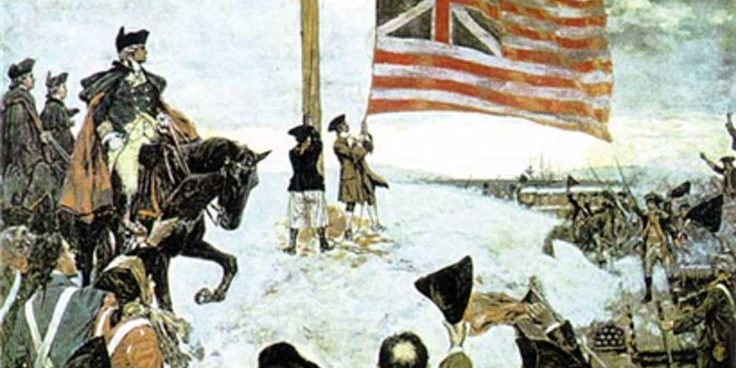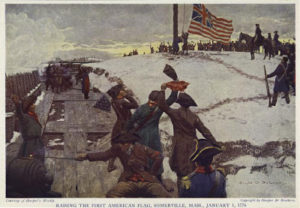 On January 1, 1776, while the British laid siege to Boston, George Washington raised the Grand Union Flag on Prospect Hill near his headquarters in Cambridge. It was the first flag of the united colonies. It was known as the Congress Colors, the First Navy Ensign and the Cambridge Flag and could be considered the official flag of the American Revolution. It had 13 red and white stripes and a blue field with the red cross of St. George of England and the white cross of St. Andrew of Scotland.
On January 1, 1776, while the British laid siege to Boston, George Washington raised the Grand Union Flag on Prospect Hill near his headquarters in Cambridge. It was the first flag of the united colonies. It was known as the Congress Colors, the First Navy Ensign and the Cambridge Flag and could be considered the official flag of the American Revolution. It had 13 red and white stripes and a blue field with the red cross of St. George of England and the white cross of St. Andrew of Scotland.
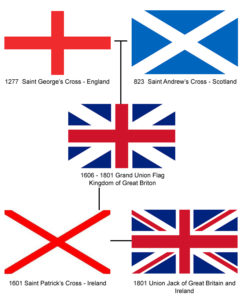 So, why did Washington raise a flag that was so similar to the emblem of England? A bit of history may be in order here. In 1603 King James I of England, who had been King James VI of Scotland, came to the throne as the monarch of both England and Scotland after Queen Elizabeth died. Though the two nations would not officially be joined until 1707, he combined the flags of England (St. George’s cross) and Scotland (St. Andrews cross) into one combined symbol. Thus, both Jamestown (1607) and Plymouth (1620) sailed ships flying this combined Union flag representing the nation from which they sailed. Later, St. Patrick’s cross of Ireland (now just Northern Ireland) was added in 1801 to make England’s Union Jack of today. Thus, the United Kingdom is a combination of several nations into one kingdom and its flag bears out that history.
So, why did Washington raise a flag that was so similar to the emblem of England? A bit of history may be in order here. In 1603 King James I of England, who had been King James VI of Scotland, came to the throne as the monarch of both England and Scotland after Queen Elizabeth died. Though the two nations would not officially be joined until 1707, he combined the flags of England (St. George’s cross) and Scotland (St. Andrews cross) into one combined symbol. Thus, both Jamestown (1607) and Plymouth (1620) sailed ships flying this combined Union flag representing the nation from which they sailed. Later, St. Patrick’s cross of Ireland (now just Northern Ireland) was added in 1801 to make England’s Union Jack of today. Thus, the United Kingdom is a combination of several nations into one kingdom and its flag bears out that history.
In Scripture, a banner is a standard that depicts, in picture form, the ideas for which people are willing to give their lives. Depicting spiritual and physical warfare, Isaiah 59:19b says “When the enemy shall come in like a flood, the Spirit of the Lord shall lift up a standard against him.” We are to lift up, as a standard (like a flag), the eternal ideas, drawn from God’s Word, in the midst of a flood of evil rising around us. One of those ideas is that civil government is ordained of God and thus we owe it respect.
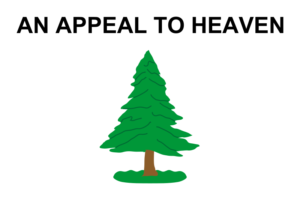
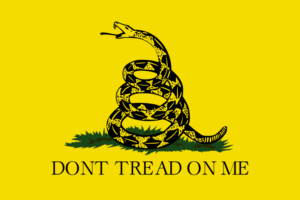 In October of 1775 George Washington created the “Appeal to Heaven” flag for his naval cruisers he had built and financed himself. With the pine tree as a symbol of religious and civil liberty, it had obvious overtones of appealing to God for the justice of the cause. Another example was the Gadsden “Don’t Tread on Me” flag inspired by the Culpeper minutemen of Virginia in 1776 emphasizing resistance to tyranny.
In October of 1775 George Washington created the “Appeal to Heaven” flag for his naval cruisers he had built and financed himself. With the pine tree as a symbol of religious and civil liberty, it had obvious overtones of appealing to God for the justice of the cause. Another example was the Gadsden “Don’t Tread on Me” flag inspired by the Culpeper minutemen of Virginia in 1776 emphasizing resistance to tyranny. 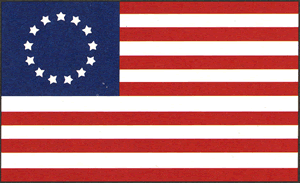 But these flags were not official and though they depicted important ideas they did not carry the weight of the Grand Union flag raising that took place January 1st, 1776. After all, Washington had just become Commander in Chief the summer before, and Independence would not be declared for six more months. The new flag (by Besty Ross), based on independence, would not be created until 1777. So what was so significant about this flag raising?
But these flags were not official and though they depicted important ideas they did not carry the weight of the Grand Union flag raising that took place January 1st, 1776. After all, Washington had just become Commander in Chief the summer before, and Independence would not be declared for six more months. The new flag (by Besty Ross), based on independence, would not be created until 1777. So what was so significant about this flag raising?
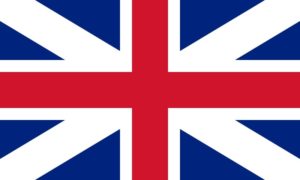 The Colonists had appealed to England on September 1, 1775 with an “Olive Branch Petition” where they asked the British Parliament and Crown to reconsider the violation of their natural rights as stated in their Charters. On October 27, 1775, the King responded with an aggressive and forceful speech that virtually severed the colonies from the mother country, saying they were “in rebellion.” No discussion of rights, rule of law or due process were addressed. It was either total submission to tyrannical rule voluntarily or by force. The British flag at that time was also called the Grand Union flag. It had the two crosses merged together to fill the entire flag – and symbolically it depicted the fact that the Crown filled the entire nation with “prerogative” and tyranny.
The Colonists had appealed to England on September 1, 1775 with an “Olive Branch Petition” where they asked the British Parliament and Crown to reconsider the violation of their natural rights as stated in their Charters. On October 27, 1775, the King responded with an aggressive and forceful speech that virtually severed the colonies from the mother country, saying they were “in rebellion.” No discussion of rights, rule of law or due process were addressed. It was either total submission to tyrannical rule voluntarily or by force. The British flag at that time was also called the Grand Union flag. It had the two crosses merged together to fill the entire flag – and symbolically it depicted the fact that the Crown filled the entire nation with “prerogative” and tyranny.
The written speech of the King had been passed around the militia units in Cambridge and the troops were furious and began to burn it in their campfires. If emotional vengeance and lawless anger had been elevated by the leaders, it would have had terrible consequences. For months a new standard had been discussed that would balance the rights of the colonies with respect for the mother country. This new flag was not a flag of rebellion or anarchy. 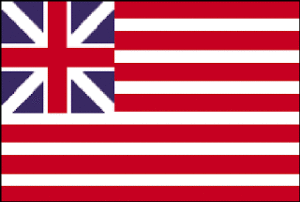 Since it contained the symbols of the original flag of England, the British, and some colonial troops, thought it was a flag of surrender to England! However, the crown emblem had been reduced in size and the main symbols were now thirteen bands alternating between red and white to signify the unity of the thirteen colonies and the fact that they would submit to the rule of law and not lawless power from the Crown. It was the first official step forward under the rule of law and away from an oath of loyalty to an individual alone.
Since it contained the symbols of the original flag of England, the British, and some colonial troops, thought it was a flag of surrender to England! However, the crown emblem had been reduced in size and the main symbols were now thirteen bands alternating between red and white to signify the unity of the thirteen colonies and the fact that they would submit to the rule of law and not lawless power from the Crown. It was the first official step forward under the rule of law and away from an oath of loyalty to an individual alone.
 When the Pilgrims sailed on the Mayflower, they planted the seed of submission to civil government as a God ordained institution. They sailed under a Patent and Charter from the King (the very one who had driven them out of England), flying the Union flag. Once landing out of the jurisdiction of their written documents, they wrote the
When the Pilgrims sailed on the Mayflower, they planted the seed of submission to civil government as a God ordained institution. They sailed under a Patent and Charter from the King (the very one who had driven them out of England), flying the Union flag. Once landing out of the jurisdiction of their written documents, they wrote the 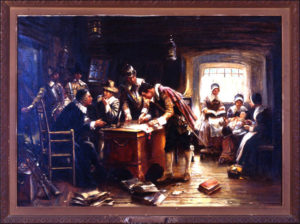 Mayflower Compact and stated, “In the name of God Amen. We whose names are underwritten, the loyal subjects of our dread Sovereign King James.” God, to the people, and then to the King (or civil government) was a new power flow that would affect generations to come. They thus avoided anarchy and lawless behavior. Though the Pilgrims could never have envisioned the Declaration of Independence, they planted a seed of independence under God and the rule of law, functioning by the Compact they wrote under the rule of law.
Mayflower Compact and stated, “In the name of God Amen. We whose names are underwritten, the loyal subjects of our dread Sovereign King James.” God, to the people, and then to the King (or civil government) was a new power flow that would affect generations to come. They thus avoided anarchy and lawless behavior. Though the Pilgrims could never have envisioned the Declaration of Independence, they planted a seed of independence under God and the rule of law, functioning by the Compact they wrote under the rule of law.
 So what is the lesson we can learn from this flag raising on Prospect Hill in Cambridge? Though surrounded by evil and a rising tide of lawlessness just like the Colonists were under the siege of Britain in Boston, we must raise, as a banner, the proper balance of submission to the rule of law with the discernment of lawfully resisting, from a place of principled unity. We will have to do this, not just by our rhetoric, but by our actions. Most who desire to increase the size and scope of civil government do not understand that they will come to oppose its fruit in the future. People are not our enemy. We must serve others, love our enemies, and allow God’s providential Hand to move in His time. We must, however, raise the banner of the ideas of Christian self-government and submissive yet lawful resistance to tyranny! If we do this, our children and grandchildren will thank us! Let us raise up the banner of truth!
So what is the lesson we can learn from this flag raising on Prospect Hill in Cambridge? Though surrounded by evil and a rising tide of lawlessness just like the Colonists were under the siege of Britain in Boston, we must raise, as a banner, the proper balance of submission to the rule of law with the discernment of lawfully resisting, from a place of principled unity. We will have to do this, not just by our rhetoric, but by our actions. Most who desire to increase the size and scope of civil government do not understand that they will come to oppose its fruit in the future. People are not our enemy. We must serve others, love our enemies, and allow God’s providential Hand to move in His time. We must, however, raise the banner of the ideas of Christian self-government and submissive yet lawful resistance to tyranny! If we do this, our children and grandchildren will thank us! Let us raise up the banner of truth!

